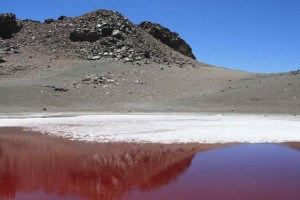13 December 2010
Searching for life on Earth
Posted by mohi
Europa is actually in Alaska. Mars? That’s in Newfoundland. And the Canadian high Arctic. And the Andes.
What?
It’s like the ultimate in elaborate cinema: terrestrial oddities serving as stunt doubles for far-flung celestial landscapes–except the scenery is real, and scientists can dive, climb and dig into the exotic vistas. Scientists use these extreme environments to study life as it might exist on the smaller, rocky bodies in our solar system–by studying microbes that persist in the face of extreme temperatures and chemical environments, and by testing whether available tools can detect life’s signatures.
The idea behind this is simple: if we can’t detect life on Earth when it’s looking at us, how will we recognize its fingerprint from many billions of miles away?
In 1990, the Galileo spacecraft flew by Earth. It detected abundant oxygen, evidence of photosynthesis, and–above all–radio transmissions of intelligent origin. The results were reported by Carl Sagan and colleagues in 1993. But how can we detect microbial life from space? Strange metabolic processes? What do we look for, and how can we build instruments to collect life’s signatures?
Studying Earth’s analogs of extraterrestrial environments was the topic of P11D and P12A, “Planetary Environments and LIfe: What do we Know? How Can We Learn From Analogs?”
Kevin Hand of the Jet Propulsion Laboratory (JPL) described methane bubbles trapped in Alaska’s ice field. Europa–one of Jupiter’s moon–is also covered in ice, and indicators of biological activity beneath the glacial surface might be embedded in its icy crust. Methanogenesis–using methane as an energy source–“is a nice, primordial metabolism that you might expect,” he said.
Damhnait Gleeson, also from JPL, introduced a population of sulfur-metabolizing microbes living in the Canadian Arctic, high up on the Borup Fiord Pass on Ellesmere Island. There, hydrogen sulfide gas from a sulfur spring is converted into elemental sulfur with distinct shapes and signatures indicating biological activity. Might we expand our astrobiological remote sensing techniques to include sulfur-sensitive instruments? Perhaps.“The case for sulfur minerals as astrobiological targets is strengthened,” she said.
In Newfoundland, Penny Morrill of Memorial University and a team of colleagues scrambled up a Mars analog where ultra-basic (pH 12) low oxygen salty springs are home to a variety of bacteria, but not the methane-consuming bugs they expected.
Nadia Mykytczuk of McGill University went searching in the Canadian Arctic and found perhaps some of the most extreme organisms yet–“little green bugs” that live happily at –15C in briny permafrost, burp methane, and are host to a pile of genes that make the sugary analog of protective fleece outerwear.

Organisms in central Chile's Simba lake, one of the highest lakes in the world, may help scientists understand how life could exist in the UV-bombarded thin atmosphere of Mars. Photo courtesy of BLM
Also explored: Extremely high altitude lakes in the Andes. The SETI Institute’s Nathalie Cabrol and colleagues routinely journey to altitudes higher than 4000 meters in search of analogs for climate change on Mars. They scuba dive and swim in Lake Licancabur (5916 meters). They enjoy the scenery of the reddish Lake Simba (5870 meters) and the green and white, appropriately-named Lagunas Verde and Blanca (4340 meters). The latter two lakes are surrounded by microbial mats. In this high-altitude environment, protective ozone is thin allowing ultraviolet rays fly fast and furious. Nevertheless, life is abundant.
Using analogs of extreme life on Earth, though imperfect, is the best way to approach how to detect potential life on other celestial bodies. “The Earth is not Mars–there is no such thing a perfect analog,” said Cabrol. “But we all have our favorites.”
–Nadia Drake is a science communication graduate student at UC Santa Cruz










 GeoSpace is a blog on Earth and space science, managed by AGU’s Public Information staff. The blog features posts by AGU writers and guest contributors on all sorts of relevant science topics, but with a focus on new research and geo and space sciences-related stories that are currently in the news.
GeoSpace is a blog on Earth and space science, managed by AGU’s Public Information staff. The blog features posts by AGU writers and guest contributors on all sorts of relevant science topics, but with a focus on new research and geo and space sciences-related stories that are currently in the news.
[…] of the solar system, by looking to the skies and investigating extreme situations on earth, like high-altitude lakes and an acidic […]